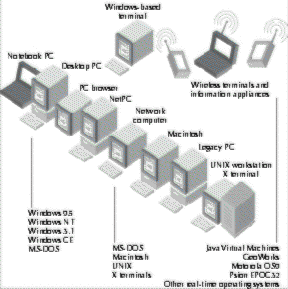
So far in this book, you’ve learned about what thin-client/server computing is, about what it takes to deploy client/server and Web-based applications using a thin-client/server model, and about how Microsoft Windows NT Server provided a great foundation on which Citrix Systems built WinFrame. You’ve also seen how well the Independent Computing Architecture (ICA) works on any client platform—whether MS-DOS, Microsoft Windows 3.x, Microsoft Windows 95, Microsoft Windows NT, Apple Macintosh, or UNIX—regardless of available bandwidth.
ICA works on any client platform regardless of available bandwidth.
In this chapter, I’ll describe the range of computing platforms and hardware devices that are enabled by the Citrix ICA client. As you can see in Figure 4-1 on page 74, you have a lot to choose from. The purpose of this book is to provide information that will help you decide where and when to add thin-client/server computing to your IS infrastructure. The thin-client/server model allows you to deploy applications rapidly regardless of available hardware and provides you with the flexibility to choose the hardware device, thick or thin, that’s best suited to your users’ job requirements. Because of this freedom to choose among a range of devices, you can allow the form of the device you select to follow the function required for the job—a choice far preferable to shoe-horning a fully configured workstation onto every employee’s desk.
With thin-client/server solutions, you can choose a hardware device in the form required for a job function.
FIGURE 4-1
Using the ICA thin-client/server software allows access from almost any type of device.
